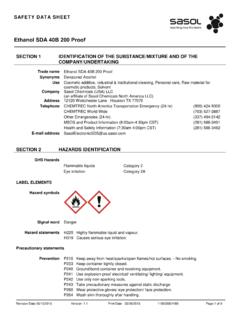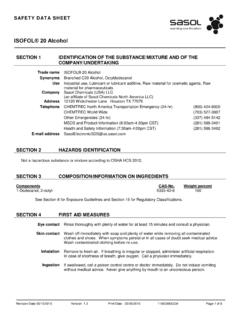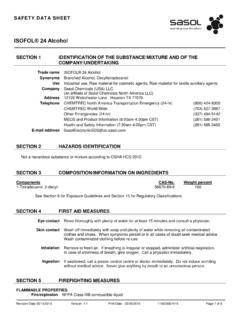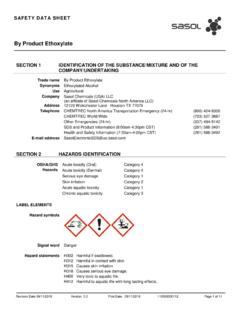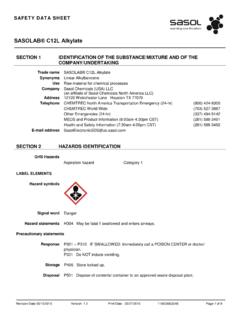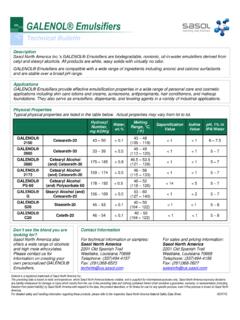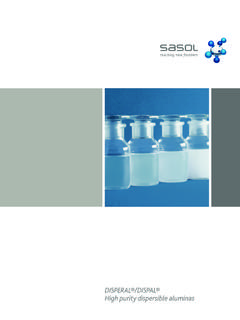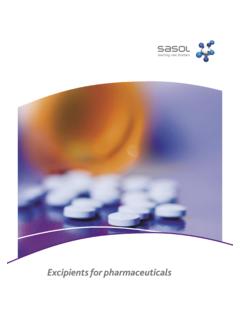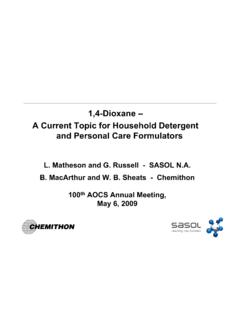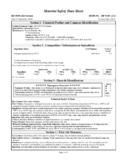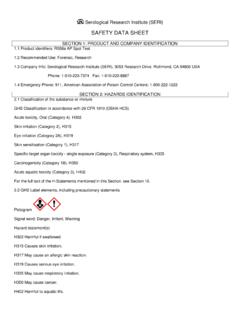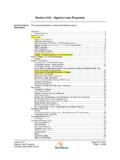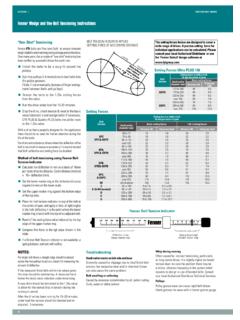Transcription of SAFETY DATA SHEET SECTION 1 IDENTIFICATION OF THE ...
1 Light Aromatic Concentrate Revision Date 04/24/2018 Version Print Date 04/24/2018 110000001325 Page 1 of 12 S AFET Y D AT A SH EET SECTION 1 IDENTIFICATION OF THE substance /MIXTURE AND OF THE COMPANY/UNDERTAKING Trade name Light Aromatic Concentrate Synonyms Pyrolysis Gasoline, Pentane Aromatics, Light Pygas Use Fuel, Industrial use, Raw material for chemical processes Company Sasol Chemicals (USA) LLC (an affiliate of Sasol Chemicals North America LLC) Address 12120 Wickchester Lane Houston TX 77079 Telephone CHEMTREC North America Transportation Emergency (24-hr) (800) 424-9300 CHEMTREC World Wide (703) 527-3887 Other Emergencies (24-hr) (337) 494-5142 SDS and Product Information (8:00am-4:30pm CST) (281) 588-3491 Health and SAFETY Information (7:30am-4:00pm CST) (281) 588-3492 E-mail address SECTION 2 HAZARDS IDENTIFICATION OSHA/GHS Hazards Flammable liquids Category 2 Carcinogenicity Category 1A Germ cell mutagenicity Category 1B Specific target organ toxicity - repeated exposure Category 1 Aspiration hazard Category 1 Eye irritation Category 2A Skin irritation Category 2 Chronic aquatic toxicity Category 2 Hazard symbols Signal word Danger Hazard statements H225 Highly flammable liquid and vapour.
2 H304 May be fatal if swallowed and enters airways. H315 Causes skin irritation. H319 Causes serious eye irritation. LABEL ELEMENTS Light Aromatic Concentrate Revision Date 04/24/2018 Version Print Date 04/24/2018 110000001325 Page 2 of 12 S AFET Y D AT A SH EET H340 May cause genetic defects. H350 May cause cancer. H372 Causes damage to organs through prolonged or repeated exposure. H411 Toxic to aquatic life with long lasting effects. Precautionary statements Prevention P210 Keep away from heat/sparks/open flames/hot surfaces. No smoking. P240 Ground/bond container and receiving equipment. P241 Use explosion-proof electrical/ ventilating/ lighting/ equipment. P280 Wear protective gloves/ protective clothing/ eye protection/ face protection. P201 Obtain special instructions before use. P202 Do not handle until all SAFETY precautions have been read and understood.
3 P260 Do not breathe dust/ fume/ gas/ mist/ vapours/ spray. P264 Wash skin thoroughly after handling. P270 Do not eat, drink or smoke when using this product. P273 Avoid release to the environment. Response P303 + P361 + P353 IF ON SKIN (or hair): Remove/ Take off immediately all contaminated clothing. Rinse skin with water/ shower. P370 + P378 In case of fire: Use water spray, alcohol-resistant foam, dry chemical or carbon dioxide for extinction. P301 + P310 IF SWALLOWED: Immediately call a POISON CENTER/doctor. P331 Do NOT induce vomiting. P332 + P313 If skin irritation occurs: Get medical advice/ attention. P305 + P351 + P338 IF IN EYES: Rinse cautiously with water for several minutes. Remove contact lenses, if present and easy to do. Continue rinsing. P337 + P313 If eye irritation persists: Get medical advice/ attention. P308 + P313 IF exposed or concerned: Get medical advice/ attention.
4 P314 Get medical advice/ attention if you feel unwell. P391 Collect spillage. Storage P403 + P405 + P235 Store locked up in a well-ventilated place. Keep cool. SECTION 3 COMPOSITION/INFORMATION ON INGREDIENTS Components CAS-No. Weight percent Benzene 71-43-2 30 - 60 Dicyclopentadiene 77-73-6 <25 Cyclopentadiene 542-92-7 <20 Styrene 100-42-5 <10 Toluene 108-88-3 <10 Naphthalene 91-20-3 <5 Pentane 109-66-0 <3 Light Aromatic Concentrate Revision Date 04/24/2018 Version Print Date 04/24/2018 110000001325 Page 3 of 12 S AFET Y D AT A SH EET Heptane 142-82-5 <2 Hexane 110-54-3 <2 Indene 95-13-6 <2 Octane 111-65-9 <2 Benzene, ethyl- 100-41-4 <2 Xylene 1330-20-7 <2 Cyclohexadiene 628-41-1 <2 See SECTION 8 for Exposure Guidelines and SECTION 15 for Regulatory Classifications. SECTION 4 FIRST AID MEASURES Eye contact Rinse thoroughly with plenty of water for at least 15 minutes and consult a physician.
5 Skin contact Wash off immediately with soap and plenty of water while removing all contaminated clothes and shoes. If skin irritation persists, call a physician. Inhalation Remove to fresh air. If breathing is irregular or stopped, administer artificial respiration. In case of shortness of breath, give oxygen. Call a physician immediately. Ingestion If swallowed, call a poison control centre or doctor immediately. Do not induce vomiting without medical advice. Never give anything by mouth to an unconscious person. SECTION 5 FIREFIGHTING MEASURES FLAMMABLE PROPERTIES Fire/explosion Vapours may form explosive mixture with air. Fire will produce dense black smoke containing hazardous combustion products (see SECTION 10). NFPA Class 1B flammable liquid. Suitable extinguishing media Water spray, Foam, Dry chemical, Carbon dioxide (CO2) Protective equipment and precautions for firefighters Wear self-contained breathing apparatus and protective suit.
6 Further information Prevent further leakage or spillage if safe to do so. Evacuate personnel to safe areas. SECTION 6 ACCIDENTAL RELEASE MEASURES Methods and materials for containment and cleaning up Evacuate the area and eliminate all sources of ignition. Contain spillage, and then collect with non-combustible absorbent material, ( sand, earth, diatomaceous earth, vermiculite) and place in container for disposal according to local / national regulations (see SECTION 13). Light Aromatic Concentrate Revision Date 04/24/2018 Version Print Date 04/24/2018 110000001325 Page 4 of 12 S AFET Y D AT A SH EET SECTION 7 HANDLING AND STORAGE Safe handling advice Take measures to prevent the build up of electrostatic charge. Ensure all equipment is electrically grounded before beginning transfer operations. Storage/Transport pressure Ambient Load/Unload temperature Ambient SECTION 8 EXPOSURE CONTROLS/PERSONAL PROTECTION ENGINEERING MEASURES Air contaminant levels should be controlled below the PEL or TLV for this product (see Exposure Guidelines).
7 PERSONAL PROTECTIVE EQUIPMENT Eyes Wear as appropriate: Goggles, Face-shield Skin Wear suitable protective clothing, gloves and eye/face protection. Inhalation When workers are facing concentrations above the exposure limit they must use appropriate certified respirators. Use NIOSH approved respiratory protection. EXPOSURE GUIDELINES Components Exposure limit(s) Benzene OSHA TWA 1 ppm OSHA STEL (Short Term Exposure Limit) 5 ppm ACGIH TLV (8-hour) ppm ACGIH STEL (Short Term Exposure Limit) ppm Dicyclopentadiene ACGIH TLV (8-hour) 5 ppm Cyclopentadiene ACGIH TLV (8-hour) 75 ppm OSHA PEL (Permissible Exposure Limit) 75 ppm 200 mg/m3 Styrene OSHA PEL (Permissible Exposure Limit) 100 ppm ACGIH TLV (8-hour) 20 ppm 85 mg/m3 OSHA Ceiling 200 ppm ACGIH STEL (Short Term Exposure Limit) 40 ppm 170 mg/m3 Toluene ACGIH TLV (8-hour) 20 ppm OSHA TWA 200 ppm OSHA Ceiling 300 ppm OSHA STEL (Short Term Exposure Limit) 150 ppm Naphthalene OSHA PEL (Permissible Exposure Limit) 10 ppm 50 mg/m3 Light Aromatic Concentrate Revision Date 04/24/2018 Version Print Date 04/24/2018 110000001325 Page 5 of 12 S AFET Y D AT A SH EET ACGIH TLV (8-hour)
8 10 ppm 50 mg/m3 NIOSH Recommended Exposure Limit 10 ppm 50 mg/m3 NIOSH Short term exposure limit 15 ppm 75 mg/m3 NIOSH NIOSH IDLH (Immediately Dangerous to Life or Health Concentrations) 250 ppm Pentane ACGIH TLV (8-hour) 1,000 ppm OSHA PEL (Permissible Exposure Limit) 1,000 ppm 2,950 mg/m3 NIOSH Ceiling 610 ppm 1,800 mg/m3 Heptane OSHA PEL (Permissible Exposure Limit) 500 ppm 2,000 mg/m3 ACGIH TLV (8-hour) 400 ppm 1,640 mg/m3 ACGIH STEL (Short Term Exposure Limit) 500 ppm 2,050 mg/m3 NIOSH Ceiling 440 ppm 1,800 mg/m3 Hexane ACGIH TLV (8-hour) 50 ppm OSHA PEL (Permissible Exposure Limit) 500 ppm 1,800 mg/m3 *Skin Hazard: Skin exposure should be prevented or reduced to control skin absorption. Indene ACGIH TLV (8-hour) 5 ppm Octane ACGIH TLV (8-hour) 300 ppm OSHA PEL (Permissible Exposure Limit) 500 ppm 2,350 mg/m3 Benzene, ethyl- OSHA PEL (Permissible Exposure Limit) 100 ppm ACGIH TLV (8-hour) 20 ppm Xylene OSHA PEL (Permissible Exposure Limit) 100 ppm 435 mg/m3 ACGIH TLV (8-hour) 100 ppm ACGIH STEL (Short Term Exposure Limit) 150 ppm PEL= Permissible Exposure Limits TWA= Time Weighted Average (8 hr.)
9 TLV= Threshold Limit Value STEL= Short Term Exposure Limit (15 min.) EL= Excursion Limit WEEL= Workplace Environmental Exposure Level SECTION 9 PHYSICAL AND CHEMICAL PROPERTIES Appearance liquid; Colour clear yellowish Form liquid Odour strong aromatic Odour Threshold No data available Flash point < -11 C, < 12 F; D-56; Light Aromatic Concentrate Revision Date 04/24/2018 Version Print Date 04/24/2018 110000001325 Page 6 of 12 S AFET Y D AT A SH EET Flammability Upper explosion limit: %(V) Lower explosion limit: %(V) Boiling point/boiling range 48 - 179 C, 120 - 355 F; ASTM D-86; Melting point/range Pour point: -45 C, -50 F; ASTM D-97; Auto-ignition temperature Not available Decomposition temperature No data available Flammability (solid, gas) No data available Vapour pressure psia @ 38 C, 100 F; Vapour density 2 - 3 Density lb/gal Specific gravity Water solubility negligible Viscosity No data available pH No data available Evaporation rate No data available Partition coefficient: n-octanol/water No data available SECTION 10 STABILITY AND REACTIVITY Reactivity No decomposition if stored and applied as directed.
10 Chemical stability Stable under recommended storage conditions. Conditions to avoid Keep away from heat and sources of ignition. Hazardous decomposition products Carbon oxides Light Aromatic Concentrate Revision Date 04/24/2018 Version Print Date 04/24/2018 110000001325 Page 7 of 12 S AFET Y D AT A SH EET Materials to avoid Oxidizing agents Hazardous polymerisation None. SECTION 11 TOXICOLOGICAL INFORMATION Additional Remarks This product contains polynuclear hydrocarbons. Some polynuclear aromatic hydrocarbons have been shown to cause skin tumors in laboratory test animals. Acute dermal toxicity No data available Acute inhalation toxicity No data available Acute oral toxicity No data available Skin corrosion/irritation Test substance : Benzene and other aromatic hydrocarbons. Irritant Possibly toxic through skin absorption. Serious eye damage/eye irritation Test substance : Benzene and other aromatic hydrocarbons.

